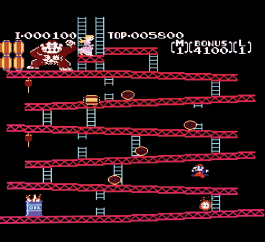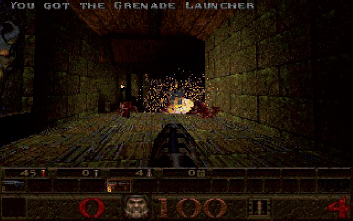The Internet and Social Gaming
Printed Page 300
With the introduction of the Sega Dreamcast in 1999, the first console to feature a built-in modem, game playing emerged as an online, multiplayer social activity. The Dreamcast didn't last, but online connections are now a normal part of console video games. Internet-connected players oppose one another in combat, fight together against a common enemy, or team up to achieve a common goal (like sustain a medieval community). With multiple players joining in electronic games through the Internet, this form of gaming has become a contemporary social medium.
Some of the biggest social-gaming titles have been first-person shooter games like Counter-Strike, an online spin-off of the popular Half-Life console game. Each player views the game from the first-person perspective but also plays in a team as terrorists or counterterrorists. The ability to play online has added a new dimension to other, less combat-oriented games, too. For example, football and music enthusiasts playing already-popular console games like Madden NFL and Rock Band can now engage with others in live online multiplayer play. And young and old alike can compete against teams in other locations in Internet-based bowling tournaments using the Wii.
The increasingly social nature of video games has made them a natural fit for social networking sites. Many online games like Lexulous (inspired by the board game Scrabble) and Farmville are now embedded in these sites. Online fantasy sports games also reach a mass audience with a major social component. Players-real-life friends, virtual acquaintances, or a mix of both-assemble teams and use actual sports results to determine scores in their online games. But rather than experiencing the visceral thrills of, say, Madden NFL 11, fantasy football participants take a more detached, managerial perspective on the game-a departure from the classic video game experience. Fantasy sports' managerial angle makes it even more fun to watch almost any televised game. That's because players focus more on making strategic investments in individual performances scattered across the various professional teams than they do in rooting for local teams. In the process, players become statistically savvy aficionados of the game overall, rather than rabid fans of a particular team. In 2011, about thirty-five million Americans played fantasy sports, according to the Fantasy Sports Trade Association.7
This kind of online community-building has also enabled a fairly recent form of gaming: the massively multiplayer online role-playing games (MMORPGs). These games are set in virtual worlds that require users to play through an avatar of their own design. The fantasy adventure game World of Warcraft is the most popular MMORPG, boasting more than eleven million players around the globe. Users can select from ten different types of avatars, including dwarves, gnomes, night elves, orcs, trolls, and humans. To succeed in the game, many players join with other players to form guilds or tribes, working together toward in-game goals that can be achieved only by teams. Second Life, a 3-D social simulation set in real time, also features social interaction. Players build human avatars, selecting from an array of physical characteristics and clothing. Then they use real money to buy virtual land and to trade in virtual goods and services.
Simulations like Second Life and MMORPGs like World of Warcraft are aimed at teenagers and adults. But one of the biggest areas in online gaming is the children's market. Club Penguin, a moderated virtual world purchased by Disney, enables kids to play games and chat as colorful penguins. Similarly, the toy maker Ganz developed the online Webkinz World to revive its stuffed animal sales. Each Webkinz stuffed animal comes with a code that lets players access the online world, play games, and care for the virtual version of their plush pets.
Online games have further fostered media convergence. World of Warcraft, for instance, is now a comic book series, a quarterly magazine, and a feature film in development with director Sam Raimi. The "massively multiplayer" aspect of MMORPGs also indicates that electronic games-once designed for solo or small-group play-have expanded to reach large groups, similar to traditional mass media.
| INNOVATIONS IN TRADITIONAL VIDEO GAMES | |||
| Innovation | Description | Examples | |
| Avatars | On-screen figures of player identification | Pac-Man, the Mario Bros. (right), Sonic the Hedgehog, Link from Legend of Zelda |  |
| Bosses | Powerful enemy characters that represent the final challenge in a stage or the entire game | Bowser from the Mario series, Hitler in Castle Wolfenstein, Donkey Kong (right) |  |
| Vertical and Side Scrolling | As opposed to a fixed screen, scrolling that follows the action as it moves up, down, or sideways in what is called a "tracking shot" in the cinema | Platform games like Jump Bug, Jungle King, and Super Mario Bros.; also integrated into the design of Angry Birds (right) |  |
| Isometric Perspective (also called Three-Quarters Perspective) | An elevated and angled per-spective that enhances the sense of three-dimensionality by allowing players to see the tops and sides of objects | Zaxxon (right), real-time strategy games like StarCraft, god games like Civilization and Populous |  |
| First-Person Perspective | Presents the gameplay through the eyes of your avatar | First-person shooter (FPS) games like Castle Wolfenstein, Doom (right), Halo, and Call of Duty |  |
| Third-Person Perspective (or Over-the-Shoulders Perspective) | Enables you to view your heroic avatar in action from an external viewpoint | Tomb Raider (right), Assassin's Creed, and the default viewpoint on World of Warcraft |  |
| Cut Scenes (also called In-Game Cinematic or In-Game Movie) | Narrative respite from gameplay, providing cinematic scenes that advance the story. They often appear at the beginning of games and between levels. | A well-known early example appears in Maniac Mansion (1987). Cut scenes from games like the Grand Theft Auto series (right) have become increasingly vivid and complex. |  |